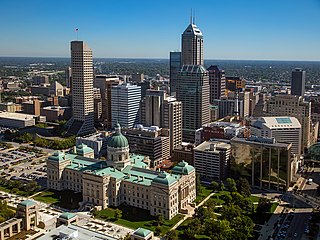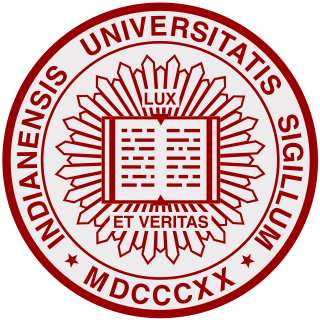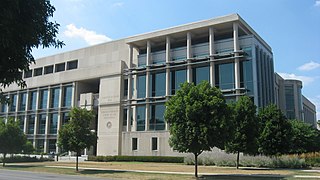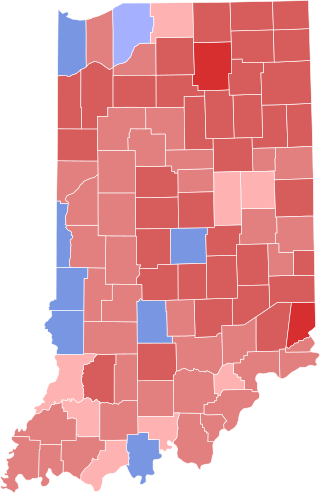
Gary is a city in Lake County, Indiana, United States. The city has been historically dominated by major industrial activity and is home to U.S. Steel's Gary Works, the largest steel mill complex in North America. Gary is located along the southern shore of Lake Michigan about 25 miles (40 km) southeast of downtown Chicago, Illinois. The city is adjacent to the Indiana Dunes National Park, and is within the Chicago metropolitan area.

Indianapolis, colloquially known as Indy, is the capital and most populous city of the U.S. state of Indiana and the seat of Marion County. According to the 2020 United States census, the balance population was 887,642. It is the 16th-most populous city in the U.S., the third-most populous city in the Midwest after Chicago and Columbus, Ohio, and the fourth-most populous state capital after Phoenix, Arizona, Austin, Texas, and Columbus. The Indianapolis metropolitan area is the 33rd-most populous metropolitan statistical area in the U.S., with 2,111,040 residents. Its combined statistical area ranks 28th, with a population of 2,431,361. Indianapolis covers 368 square miles (950 km2), making it the 18th largest city by land area in the U.S.

Thomas Andrews Hendricks was an American politician and lawyer from Indiana who served as the 16th governor of Indiana from 1873 to 1877 and the 21st vice president of the United States from March until his death in November 1885. Hendricks represented Indiana in the U.S. House of Representatives (1851–1855) and the U.S. Senate (1863–1869). He also represented Shelby County, Indiana, in the Indiana General Assembly (1848–1850) and as a delegate to the 1851 Indiana constitutional convention. In addition, Hendricks served as commissioner of the General Land Office (1855–1859). Hendricks, a popular member of the Democratic Party, was a fiscal conservative. He defended the Democratic position in the U.S. Senate during the American Civil War and Reconstruction era and voted against the Thirteenth, Fourteenth, and Fifteenth Amendments to the U.S. Constitution. He also opposed Radical Reconstruction and President Andrew Johnson's removal from office following Johnson's impeachment in the U.S. House.

Indiana University Bloomington is a public research university in Bloomington, Indiana. It is the flagship campus of Indiana University and, with over 40,000 students, its largest campus.

Michael Richard Pence is an American politician who served as the 48th vice president of the United States from 2017 to 2021 under Donald Trump. A member of the Republican Party, he previously served as the 50th governor of Indiana from 2013 to 2017, and a member of the U.S. House of Representatives from 2001 to 2013.

The Indiana Territory, officially the Territory of Indiana, was created by an organic act that President John Adams signed into law on May 7, 1800, to form an organized incorporated territory of the United States that existed from July 4, 1800, to December 11, 1816, when the remaining southeastern portion of the territory was admitted to the Union as the state of Indiana. The territory originally contained approximately 259,824 square miles (672,940 km2) of land, but its size was decreased when it was subdivided to create the Michigan Territory (1805) and the Illinois Territory (1809). The Indiana Territory was the first new territory created from lands of the Northwest Territory, which had been organized under the terms of the Northwest Ordinance of 1787. The territorial capital was the settlement around the old French fort of Vincennes on the Wabash River, until transferred to Corydon near the Ohio River in 1813.


The Indiana University Robert H. McKinney School of Law is located on the campus of Indiana University – Purdue University Indianapolis (IUPUI) in Indianapolis, Indiana, the urban campus of Indiana University. In the summer of 2001, the school moved to its new building, Lawrence W. Inlow Hall. IU McKinney is one of two law schools operated by Indiana University, the other being the Indiana University Maurer School of Law in Bloomington. Although both law schools are part of Indiana University, each law school is wholly independent of the other. According to IU McKinney's 2019 ABA-required disclosures, 59% of the Class of 2018 obtained full-time, long-term, J.D.-required employment within ten months after graduation.

Northern Indiana is a region of the U.S. State of Indiana, including 26 counties which border the states of Illinois, Michigan, and Ohio. Northern Indiana is also considered part of the Great Lakes Megalopolis. The area is generally classified into other sub-regions; Northwest Indiana is closely tied with Chicago economically, culturally, and politically and is part of the Chicago metropolitan area. The north central region centers on South Bend metropolitan area, with economic connections to southwest Michigan. Northeast Indiana is centered on the Fort Wayne metropolitan area.

The 2010 United States Senate election in Indiana took place on November 2, 2010, alongside 33 other elections to the United States Senate in other states and elections to the United States House of Representatives and various state and local elections to fill Indiana's class III United States Senate seat. Incumbent Democratic U.S. Senator Evan Bayh decided in February 2010 to retire instead of seeking a third term shortly after Republican former U.S. Senator Dan Coats, announced his candidacy for Bayh's contested seat. Bayh's announcement came one day before the filing deadline and no Democratic candidate submitted enough signatures by the deadline to run, so the State Democratic Party chose U.S. Congressman Brad Ellsworth as their nominee. The Libertarian Party nominated YMCA instructor Rebecca Sink-Burris, who had previously run against Evan Bayh in the 1998 United States Senate election in Indiana but with less success than in this election. Coats won the open seat.

Indiana is a U.S. state in the Midwestern United States. It is the 38th-largest by area and the 17th-most populous of the 50 States. Its capital and largest city is Indianapolis. Indiana was admitted to the United States as the 19th state on December 11, 1816. It is bordered by Lake Michigan to the northwest, Michigan to the north and northeast, Ohio to the east, the Ohio River and Kentucky to the south and southeast, and the Wabash River and Illinois to the west.

Indiana University (IU) is a system of public universities in the U.S. state of Indiana.

The 2016 United States Senate election in Indiana was held on November 8, 2016, to elect a member of the United States Senate to represent the State of Indiana. The election was held alongside the presidential election and 2016 Indiana elections.

The 2020 Indiana gubernatorial election was won by incumbent Republican Eric Holcomb on November 3, 2020. The election was held concurrently with the 2020 U.S. presidential election, as well as elections to the United States House of Representatives and various state and local elections.

The 2024 United States Senate election in Indiana will be held on November 5, 2024, to elect a member of the United States Senate to represent the state of Indiana. Incumbent one-term Republican Senator Mike Braun is eligible to run for a second term in office, but is instead running for Governor. This will be the first election for this seat in which there is no incumbent running since 1958.

The 2022 United States Senate election in Indiana was held on November 8, 2022 to elect a member of the United States Senate to represent the state of Indiana. Incumbent Republican Senator Todd Young was reelected to a second term.

The 2022 United States House of Representatives elections in Indiana were held on November 8, 2022, to elect the nine U.S. representatives from the state of Indiana, one from each of the state's nine congressional districts. The elections coincided with other elections to the U.S. House of Representatives, elections to the U.S. Senate, and various state and local elections. Primary elections took place on May 3.

















